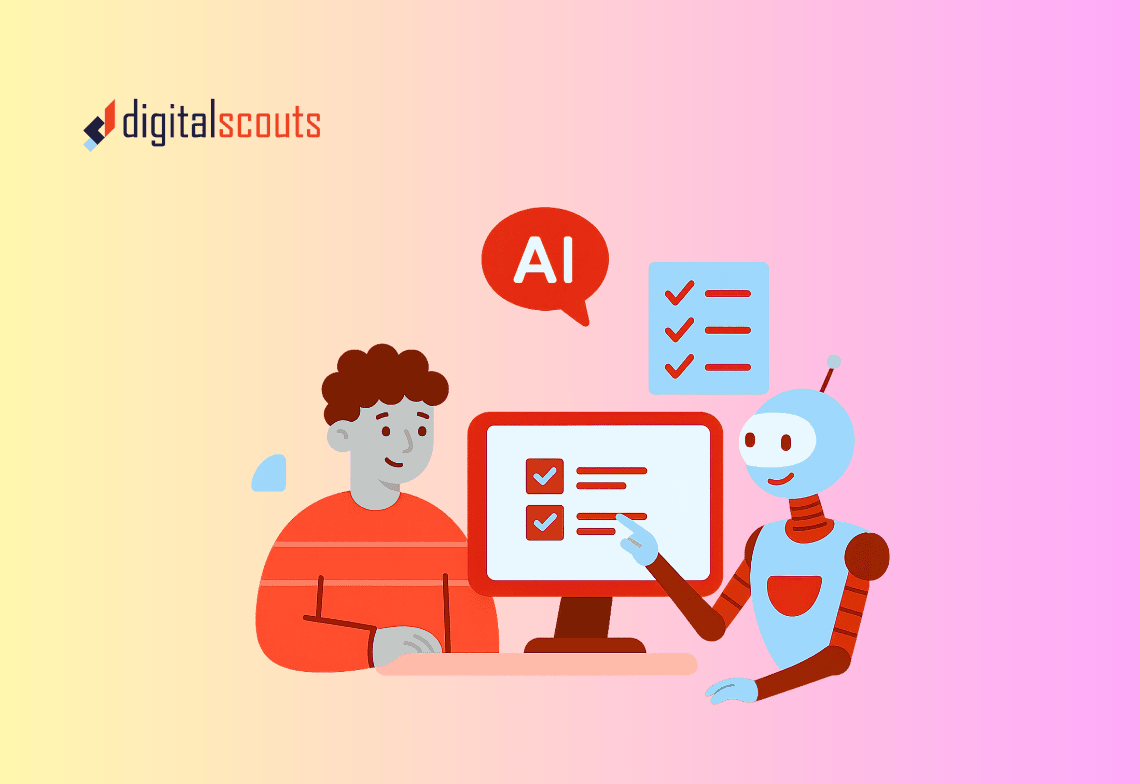Modern B2B growth depends on a steady flow of useful content that prospects can find, trust, and act on. The problem is volume and velocity. You need strategy, briefs, drafts, approvals, and distribution across many channels. Teams either slow down or quality slips.
AI changes the economics of content production. It removes busy work, accelerates decisions, and gives writers strong first drafts. Yet the goal is not more content. The goal is better outcomes. In this guide you will learn how to build an AI workflow for content production that keeps brand quality high, supports Answer Engine Optimisation, and connects to HubSpot for measurement and scale.
What AI in content marketing should solve
Before adding tools, define the jobs to be done. A clear scope keeps quality high and prevents over automation.
Use AI to
-
Turn research into outlines and first drafts
-
Improve clarity, structure, and reading flow
-
Generate on brand variations for email, social, and ads
-
Create summaries, key takeaways, and FAQs for AEO
-
Tag topics, persona, and intent for analytics in HubSpot
Do not use AI to
-
Invent product claims
-
Replace expert judgment and approvals
-
Publish without human edit and fact check
Start with a policy that your team can follow. It protects quality and makes adoption faster.
Principles that keep brand quality intact
AI is useful when you give it the right constraints. These rules are simple and effective.
One source of truth
Store voice rules, message pillars, and proof points in a shared playbook. Use this as the prompt backbone for every asset.
Human in the loop
Writers and subject experts review structure, tone, and facts. AI assists, people decide.
Measure outcomes
Quality is not only grammar. It is the effect on pipeline. Track how content moves contacts through HubSpot lifecycle stages.
Small experiments, fast learnings
Pilot AI in one step of the workflow, learn, then expand. This builds trust across marketing, sales, and leadership.
The AI optimised workflow from brief to revenue
This is the end to end process we use with B2B teams. Each step notes the role of AI, how to support AEO, and where HubSpot fits.
1. Strategy and topic selection
Start with business goals and audience pain. Build topic clusters that map to high intent searches and sales conversations.
AI assists
-
Mine interviews, chat transcripts, and win notes to surface repeated questions
-
Cluster keywords by intent groups such as problem, solution, and product
AEO support
Create a question bank for each cluster. These questions become headings and FAQ entries.
HubSpot link
Log clusters as campaigns. Tag contacts and assets so attribution is clear later.
2. Brief creation
A strong brief prevents rework. It tells the writer what to say and why it matters.
AI assists
-
Draft a structured brief from a short outline and a target persona
-
Suggest sources to cite and claims that need proof
AEO support
Add a short direct answer for the primary question at the top of the brief. This becomes the opening paragraph.
HubSpot link
Attach the brief to a campaign. Add goals such as new contacts, demo requests, or assisted pipeline.
3. Outline and research
Writers review the brief and shape the story. AI speeds up synthesis but humans choose the angle.
AI assists
-
Turn the brief into a hierarchical outline
-
Summarise key sources and extract data points that need citation
AEO support
Frame H2 and H3 headings as natural questions. Keep paragraphs short and answers clear.
4. First draft
This is where most time is saved. Keep the writer in control of structure and message. Let AI help with speed.
AI assists
-
Produce a first draft that follows the outline and brand voice rules
-
Generate variations for examples and use cases by industry or role
AEO support
-
Open each section with a 30 to 50 word direct answer
-
Add an FAQ block with three to five common questions
-
Include a short summary of key points at the end
5. Edit, fact check, and tone alignment
Quality lives here. Keep the edit focused on truth, clarity, and brand.
AI assists
-
Suggest simpler sentences, shorter paragraphs, and stronger transitions
-
Highlight claims that need a source and propose citations
-
Check for repetition and passive voice
HubSpot link
If you cite customer outcomes, align with approved case studies in your asset library. Maintain consistency across campaigns.
6. On page optimisation and structure
Make the article easy to scan for both humans and answer engines.
Checklist
-
Clear title that reflects search intent
-
Meta title and meta description that invite a click
-
Question based headings and short answer lead ins
-
Internal links to pillar pages and related posts
-
Clean URL, descriptive image alt text, and schema for Article and FAQ
HubSpot link
Use HubSpot SEO tools to check internal links and topic clusters. Publish through HubSpot Content Hub for consistent templates and tracking.
7. Repurpose for channels
One asset should feed many touchpoints. Create variants that feel native to each channel.
AI assists
-
Social posts that highlight one insight at a time
-
Email snippets for lead nurture with a clear next step
-
Ad copy and landing page variants aligned to the same promise
HubSpot link
Load email and ad variants into HubSpot. Use smart content to tailor headlines and proof by industry or lifecycle stage.
8. Publish, distribute, and promote
Distribution matters as much as creation. Plan a simple playbook you can run every week.
Steps
-
Publish to your blog and submit to search engines
-
Share on LinkedIn from brand and team profiles
-
Send a short email to a relevant segment
-
Offer the post to partners for a quote round up or resource link
HubSpot link
Schedule posts and emails inside the same campaign. This keeps reporting coherent.
9. Measure impact and improve
Tie work to revenue. Leadership will support the program when they see movement against goals.
Primary metrics
-
New contacts and qualified leads from content campaigns
-
Assisted pipeline and influenced revenue
-
Speed to first engagement and time on page by persona
Diagnostic metrics
-
Click through rate by channel
-
Scroll depth and FAQ engagement
-
Internal link journeys to product pages or demo requests
HubSpot link
Build dashboards that show asset level influence on deals. Review monthly with marketing and sales.
AEO tactics that increase visibility
Answer engines favour clarity and credibility. These small changes deliver outsized gains.
Open with the answer
State the core answer in simple language at the start of each section. Expand with detail after.
Use structured lists
Numbered steps and short bullets improve extractability.
Add FAQ sections
Each FAQ should answer one question in two or three sentences. Mark them with FAQ schema.
Link with purpose
Link to related internal pages that deepen the topic. This builds topical authority.
Keep the page fast
Fast load times, clean templates, and accessible design are signals of quality and improve engagement.
How HubSpot AI tools support this workflow
HubSpot reduces friction across content planning, production, and measurement. Use these features to keep your system in one place.
AI Content Assistant
Draft email, page copy, and variations in your brand voice. Combine with personalisation tokens for role and industry.
Content Hub and SEO tools
Manage pillar pages and topic clusters. Check internal links and on page basics before you publish.
Workflows and smart content
Trigger nurtures from content engagement. Swap proof points and case studies by industry, lifecycle stage, or account list.
Attribution and revenue reporting
Show how each asset influences pipeline and closed revenue. This turns content from a cost centre into a growth lever.
Common mistakes and how to avoid them
Publishing quantity over quality
Fix by setting a cadence you can sustain. Fewer high quality posts with clear promotion will outperform more noise.
Over reliance on AI voice
Fix by keeping writers and SMEs in the loop. Use AI to speed work, not to decide message.
Thin distribution
Fix by planning channel variants the day you write the brief. Block calendar time for promotion and partner outreach.
Weak measurement
Fix by tagging campaigns, building HubSpot dashboards, and reviewing monthly with sales.
Example checklist for your next article
| Stage | Key actions | Owner |
|---|---|---|
| Strategy | Select topic cluster and target persona. Define outcome metric. | Marketing lead |
| Brief | Draft brief with message pillars, sources, and FAQs. | Content strategist |
| Outline | Create outline and question based headings. | Writer |
| Draft | Produce first draft with short answer lead ins. | Writer with AI assist |
| Edit | Fact check, tone align, and add internal links. | Editor |
| Optimise | Add schema, meta data, and alt text. | SEO specialist |
| Repurpose | Create social, email, and ad variants. | Content marketer |
| Publish | Launch on HubSpot and schedule promotion. | Marketing ops |
| Measure | Review dashboard and share learnings. | RevOps |
This simple table keeps roles clear and cycle time short.
Bringing it all together
An AI optimised content workflow is not about robots writing your blog. It is about a reliable system that turns business goals into useful assets that prospects can find and trust. Strategy sets direction. AI speeds the work. People protect quality. HubSpot makes the process measurable.
Teams that adopt this model ship faster, rank for the questions buyers ask, and show a clear line from content to revenue. That is how content earns its seat in the growth plan.
At Digitalscouts, we help B2B teams build content engines that scale. We connect AI workflows, HubSpot systems, and AEO best practice so your content wins attention and moves pipeline.
Ready to build an AI optimised content workflow that drives revenue
Contact Digitalscouts to plan your next content sprint.
Frequently Asked Questions
About Author
Ashish is a B2B growth strategist who helps scaleups align marketing and sales through Account-Based Marketing (ABM), RevOps, and automation. At DigitalScouts, he builds scalable content engines, streamlines lead flows with HubSpot, and runs targeted GTM programs to drive predictable pipeline. He regularly shares insights on using AI and automation to power ABM and accelerate complex buyer journeys.





.png)


